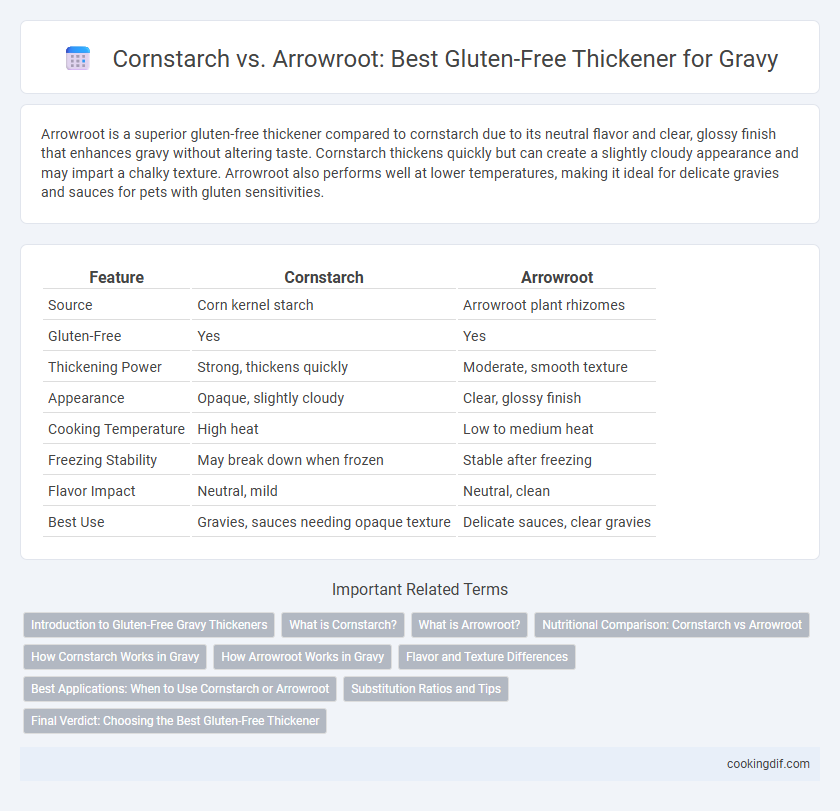Arrowroot is a superior gluten-free thickener compared to cornstarch due to its neutral flavor and clear, glossy finish that enhances gravy without altering taste. Cornstarch thickens quickly but can create a slightly cloudy appearance and may impart a chalky texture. Arrowroot also performs well at lower temperatures, making it ideal for delicate gravies and sauces for pets with gluten sensitivities.
Table of Comparison
| Feature | Cornstarch | Arrowroot |
|---|---|---|
| Source | Corn kernel starch | Arrowroot plant rhizomes |
| Gluten-Free | Yes | Yes |
| Thickening Power | Strong, thickens quickly | Moderate, smooth texture |
| Appearance | Opaque, slightly cloudy | Clear, glossy finish |
| Cooking Temperature | High heat | Low to medium heat |
| Freezing Stability | May break down when frozen | Stable after freezing |
| Flavor Impact | Neutral, mild | Neutral, clean |
| Best Use | Gravies, sauces needing opaque texture | Delicate sauces, clear gravies |
Introduction to Gluten-Free Gravy Thickeners
Cornstarch and arrowroot are popular gluten-free thickeners for gravy, each offering distinct textures and properties. Cornstarch creates a glossy, translucent finish and thickens at higher temperatures, while arrowroot provides a clear, shiny appearance with a more neutral flavor, thickening quickly at lower heat. Choosing the right thickener depends on desired gravy consistency, cooking method, and flavor profile, with both options catering to gluten-free dietary needs.
What is Cornstarch?
Cornstarch is a fine, powdery starch derived from the endosperm of corn kernels, commonly used as a gluten-free thickening agent in gravies and sauces. It forms a clear, glossy texture when cooked and is highly effective at thickening liquids quickly at medium-high heat. Compared to arrowroot, cornstarch is more widely available and cost-effective but may lose its thickening power if overcooked or exposed to acidic ingredients.
What is Arrowroot?
Arrowroot is a gluten-free starch extracted from the rhizomes of tropical plants, primarily used as a natural thickening agent in gravies and sauces. It creates a clear, glossy finish with a smooth texture, making it ideal for delicate dishes where appearance matters. Compared to cornstarch, arrowroot works well at lower temperatures and doesn't break down when mixed with acidic ingredients.
Nutritional Comparison: Cornstarch vs Arrowroot
Cornstarch contains approximately 30 calories and 7 grams of carbohydrates per tablespoon, with minimal fiber and protein, making it a high-carb thickener. Arrowroot offers about 30 calories and 7 grams of carbohydrates per tablespoon but provides slightly more resistant starch and is easier to digest, benefiting sensitive stomachs. Both thickeners are gluten-free, but arrowroot contains more potassium and fewer calories per gram when compared to cornstarch, making it a nutritionally favorable choice for gluten-free gravy.
How Cornstarch Works in Gravy
Cornstarch thickens gravy by absorbing water and swelling when heated, creating a smooth, glossy texture essential for clarity and consistency. It gelatinizes at a temperature between 144degF and 162degF, forming a translucent sauce that holds together without becoming cloudy or lumpy. Compared to arrowroot, cornstarch provides a slightly thicker gravy but may break down if exposed to prolonged high heat or acidic ingredients.
How Arrowroot Works in Gravy
Arrowroot powder creates a glossy, translucent finish in gravy, thickening at lower temperatures without breaking down or becoming gummy. It thickens by absorbing water and forming a clear gel, making it ideal for reheated or acidic gravies. Compared to cornstarch, arrowroot provides a smoother texture and maintains flavor clarity in gluten-free sauces.
Flavor and Texture Differences
Cornstarch yields a glossy, smooth texture with a neutral taste, making it ideal for creamy gravies without altering the flavor profile. Arrowroot creates a silky, somewhat translucent finish and imparts a slightly earthy flavor, enhancing gravies with subtle complexity. Both thickeners effectively achieve gluten-free consistency, but arrowroot thickens at a lower temperature and retains clarity better than cornstarch.
Best Applications: When to Use Cornstarch or Arrowroot
Cornstarch excels in thickening gravies with a glossy finish and is ideal for high-heat cooking or acidic ingredients, making it suitable for gravies that require prolonged simmering. Arrowroot, with its clear, shiny consistency and neutral flavor, is perfect for delicate gravies and those served cold or frozen, as it thickens quickly at low temperatures without breaking down. Both gluten-free thickeners perform best when added toward the end of cooking; choose cornstarch for heartier, robust gravies and arrowroot for light, clear sauces with subtle flavors.
Substitution Ratios and Tips
Cornstarch and arrowroot offer effective gluten-free thickening options with different substitution ratios; use 1 tablespoon of cornstarch or arrowroot powder per cup of liquid to achieve comparable viscosity. Cornstarch requires cooking to activate its thickening properties and may become cloudy when cooled, while arrowroot thickens at lower temperatures, produces a clearer gravy, and freezes better. For best results, mix arrowroot with cold water before adding to hot liquids and avoid prolonged cooking to maintain its thickening power and a smooth texture.
Final Verdict: Choosing the Best Gluten-Free Thickener
Arrowroot provides a clearer, shinier finish and maintains its thickening power at lower temperatures, making it ideal for glossy gluten-free gravies. Cornstarch offers a more opaque appearance and a slightly heavier texture but performs well under higher heat conditions. For the best gluten-free thickener, arrowroot is recommended when clarity and a smooth consistency are desired, while cornstarch suits recipes requiring robust heat tolerance.
Cornstarch vs Arrowroot for gluten-free thickener Infographic

 cookingdif.com
cookingdif.com